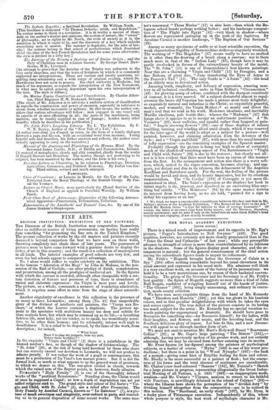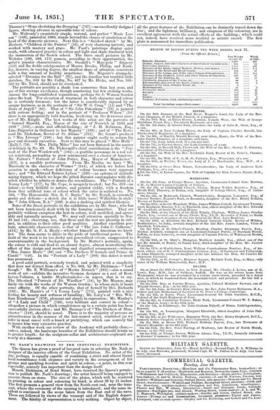THE ROYAL ACADEMY EXHIBITION.
[rims notice.]
There is a mixed result of improvement and its opposite in Mr. Egg's
picture, " Pepys's Introduction to Nell Gwynne " (429). The good qualities, however, are certainly not more clearly pronounced than in the- " Peter the Great and Catharine" of last year ; while any perceptible advance in strength of colour is more than counterbalanced by an inkiness in the shadows. Some of the figures display good character, and the ar- rangement is natural; but the general consciousness of the chief action among the subordinate figures tends to impair its refinement.
Mr. Frith's " Hogarth brought before the Governor of Calais as a Spy " (204) offers nothing remarkable beyond his usual cleverness in its usual amount and expressed in his usual style. His admirers will think it a very excellent work, on account of the variety of its personations we hold it to be a very meretricious one, by reason of their hacknied conven- tionality. The group of the Governor and his Secretary is of Mr. Frith's best quality : the figure of Hogarth suggests no more than a kind of John. Bull Scapin, confident of wriggling himself out of the hands of justice. "The Gleaner" (502), being simply unmeaning, and ordinary in execu- tion, needs scanty criticism.
We have seen more exquisite things from the hand of Mr. Kennedy than " Theodore and Honoria" (589) ; yet this too glows in his luscious colour, and in that peculiar delightfulness with which he takes the eyes and senses captive. The true defect of the picture consists in its having too much subject for the artist : Mr. Kennedy has no special vocation to- wards painting the supernatural or dramatic. He should have gone to Boccaccio for something else—for Boccaccio himself ; for the ladies, with their laughter, and flowers, and music, and the brooding heat, and the Southern delicious glory of repose. Let him do this, and a new Decame- ron will appeal to us through another form of art. We must not omit to mention Mr. Hart's Holy-well Street "Benvenuto Cellini " (20) ; or Mr. Cope's large painting, " The Sisters " (161),— although, having previously spoken of his greater work, and not entirely admiring this, we may be excused from further entering into its merits. Mr. Frost figures (or lay-figures) among the painters of mythological subjects, as a matter of course. "Ryles" (560) is one of his worst pro- ductions ; but there is a point in his " Wood Nymphs" (407)—the back of a nymph—giving some hint of Ettylike feeling for form and colour. Mr. Brocky is far more successful as a painter of flesh ; but the coarse- ness of his forms and the total absence of sentiment are unendurable. Mr. Chalon's raw-beef-coloured " Seasons " (102), Mr. Tenniel's " Sketch for a large picture in progress, representing allegorically the Great Indus- trial Meeting of all Nations, A.D. 1851 " (383)—an inappropriate medi- , asvalism—and Mr. twine's "Ulysses, anxious to return to his faithful wife Penelope, is unwillingly detained in the island of Calypso" (35)— where the Ithacan hero shows the perception of his " divided duty" by dividing himself altogether from the composition—are to be noticed in this section. The " Bacchanal, an early study " (107), by Mr. Dyce, is a dusky piece of Titianesque execution, Independently of this, whose whole purpose is style, the best work of mythologic character is Mr.
Thomas's "Hope cherishing the Drooping" (737)-an excellently designel figure, showing advance in agreeable tone of colour.
Mr. Muheady's exquisitely simple, natural, and perfect " Music Les- son" (168), painted in 1809, stands beyond the chance of emulation at the head of the domestic pictures. Next this is a " finished sketch " by Mr. Herbert, "Children of the Painter" (33), of very charming naiveté, and worked with mastery and grace. Mr. Feed's paintings display quiet truth, with educated practice in colour and light and shade tinctured with the mannerism of the Scotch school. The three small pictures by Mr. Webster (106, 108, 173) possess, according to their opportunities, the artist's popular characteristics. Mr. Goodall's " May-pole " frippery (552) and the feeble catchpennies of Messrs. Brooks, Philip, and Rank- ley, deserve, in varying degree, the smallest share of attention consistent with a due amount of healthy impatience. Mr. Maguire's strangely- selected "Dressing for the Ball" (91), and the familiar but truthful little sketches, No. 359 by Mr. Colby, No. 467 by Mr. Hicks, and Nos. 358- 360 by Mr. Nicol, should not be overlooked.
The portraits are possibly a shade less numerous than last year, and are of fair average excellence, though numbering but few striking works. Among the long-established reputations, perhaps Sir J. Watson Gordon takes the lead. For elevation of treatment in both character and colour he is certainly foremost; but the latter is considerably injured by an opaque haziness, as in the portraits of "Sir W. G. Craig" (15) and "The Duke of Argyll" (61). That of " Sir John Pakenham " (76) is painted with serious feeling ; and in the portrait of " Professor Wilson" (50) there is an appropriately bold freedom, bordering on the dexterous man- ner of Mr. Knight. The best works of this artist are the portraits of " Samuel Bignold, Esq., Mayor of the city of Norwich in 1833 and 1838 " (195),-acute and official-looking ; of " J. H. Robinson, Esq., Line-Engraver in Ordinary to her Majesty" (198) ; and of " The Reve- rend Dr. Nicholson, Rector of St. Albans " (522). Mr. Grant's prettiest is " Mrs. Livesay" (190) ; but this painter ought really to reform his poor and slovenly execution. Next to this may be placed " Miss Malli " (Ralli ?) (70). " Mrs. Philip Miles" has not been flattered in the matter of delicacy in No. 69. Mr. Pickersgill's chief contribution is the " Por- trait of the Poet Wordsworth" (184)-a goatlike personage in a red vel- vet waistcoat, pretending to grow sentimental over a cluster of foxglove. Mr. Patten's " portrait of John Potter, Esq., Mayor of Manchester" (203), is a sensible performance. From Mr. Maclise we have " Mr. Macready in the character of Werner" (644), of which we before had occasion to speak-whose deficiency of colour becomes very apparent here ; and " Sir Edward Bulwer Lytton " (238)-an epitome of attitudi- nizing foppery, which we hope the gifted Baronet contemplates with dis- relish whether he admits or denies the resemblance. The " Portrait of a Young Lady" (177), by Mr. Cope, is meagrely treated; but No. 593-an infant-is very faithful to nature, and painted richly, with a freedom from that artificial tone of colour which the artist is addicted to. No. 566, " The Honourable Mrs. R. C. Boyle," by Mr. Boxall, is extremely pretty and delicate-a sketch (for it is little more) Wilkielike in style : the " John Gibson, R.A." (180) is also a dashing and spirited likeness.
Some of the finest portraits in the exhibition are by Mr. Sant ; who has not been handsomely dealt with by the hanging committee. They are probably without exception the best in colour, well modelled, and agree- ably and naturally arranged. We may call attention specially to Nos. 51 and 142 ; observing, too, that these and the rest are pleasing in sub- ject, in addition to their other good qualities. Another excellent por- trait, admirably characteristic, is that of "The late John C. Calhoun," (415,) by Mr. G. P. A. Healy-whether himself an American we know not. The form seems to dilate in the pride of intellectual power. The fault of the work is its too dusky and generalized colour, exaggerated to conventionality in the background. In Mr. Mottez's portraits, again, the colour is cold and dead to an absurd degree, almost neutralizing the effect of fine design and modelling and dignified arrangement-witness "Mrs. James Hertz" (86) and "The Duchess D'Aumale and Prince de Conde" 1146). In the "Portrait of a Lady" (598) this defect is much less prominent.
A good solid portrait, seriously treated, and painted with a simplicity that does not detract from effect, is No. 668, by Mr. Dickinson--" Lord Gough." Mr. E. Williams's of "Moritz Retzsch" (181)-also a sound work of art-exhibits the inventive German designer as a sort of Beet- hoven-Voltaire, a herdic Mephistopheles-in aspect, that is to say. The life-sized "Portrait of Dr. Wardlaw" (54), by Mr. Macnee, may fairly vie with the works of Sir Watson Gordon ; to whose style it bears some affinity. Of the other portraits, that of herself by Mrs. Richards (166) ; Mr. Harris's of " A Young Lady" (774), painted with a nice feeling for beauty and softness of handling ; Mr. Lucy's of "Mrs. Wil- liam Henderson" (378), pleasant snd simple in expression ; Mr. Manley's of "A Lady and Child" (730), very brilliant and correct in colour- altogether a picture in which completeness up to a certain point has been successfully striven after ; and Mr. Desange's of " The Duchess of Man- chester" (119), should be noted. There is to the majority of persons an attractiveness in the manner of the last-named artist, combined (as we infer in most cases) with a knack at prettifying, which can scarcely fail to insure him very extensive practice.
With another week our review of the Academy will probably close,- unless, indeed, the landscape beauties of the Exhibition should detain us to greater length; for the sculpture-cellar and architecture-cupboard are nearly at a discount.



























 Previous page
Previous page